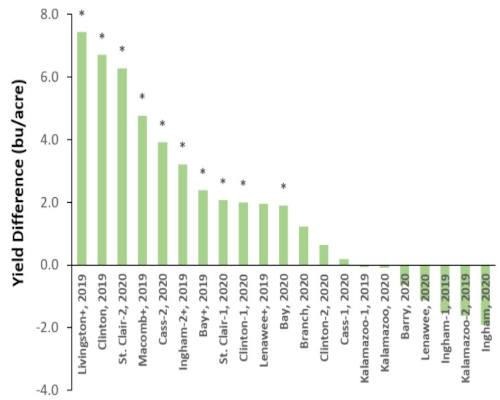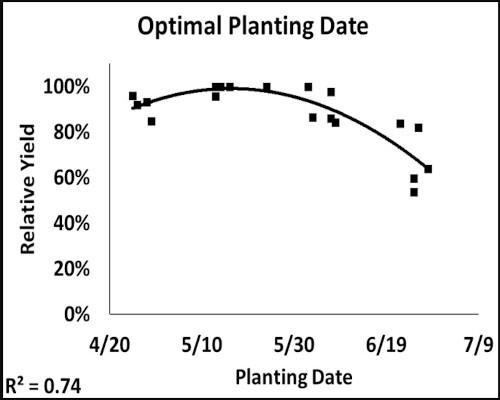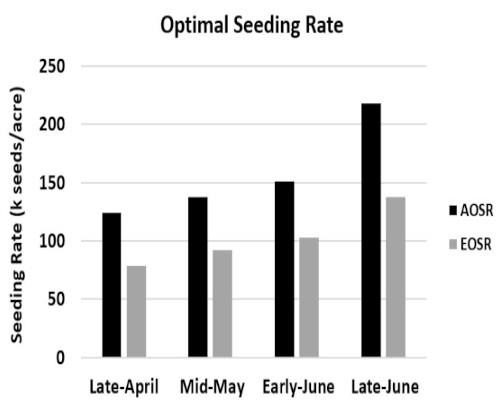On-farm trials were conducted to compare early-season soybean planting dates with normal soybean planting dates in 2019 and 2020. Growers were asked to plant soybean three weeks apart in a randomized strip trial design with four replications and collect yield data from each strip. Early season planting resulted in significantly higher yields at five out of nine locations in 2019 (average yield increase of 2.6 bushels per acre, some fields had in-season pesticide application along with early planting) and at five out of 12 fields in 2020 (average yield increase of 1.2 bushels per acre) (Figure 1). None of the field reported significant yield loss from early-season planting.

Figure 1. Yield difference (early - late planting, separated by around three weeks) across various locations during the 2019 and 2020 growing seasons. * Denotes locations with significant yield differences. + Denotes 2019 locations with fungicide/insecticide spray at R3 stage (beginning pod) in early planting.
Small plot research trials were conducted between 2018 and 2020 using three to four planting dates ranging from late April to late June. Results from these studies show that optimal soybean planting is during or before mid-May (Figure 2). Delayed planting after mid-May resulted in a yield penalty, which increased as planting was delayed. On average, soybean yield was reduced by 0.4% per day between the mid-May and early June planting dates. Furthermore, planting after early-June resulted in an average yield reduction of 1.2% per day.
Overall, the results from these studies suggest that avoiding delayed soybean planting is critical to maximizing yield potential.

Figure 2. Relationship between planting date and relative yield during the 2018, 2019 and 2020 growing seasons.
Management based on planting date
In 2018 and 2019, small plot research was conducted at Mason and Saginaw, Michigan, to determine how optimal maturity group selection, seeding rate and seed treatment decisions are impacted by soybean planting date. Results from this research showed that the benefits of early season soybean planting can be improved (with a more than 3 bushel per acre advantage) by using a variety with a later maturity group designation (Figure 3). Furthermore, when planting was delayed to late-June, using an early-maturity variety not only provided small yield advantage but also resulted in soybean seed with low moisture content at the time of harvest. Using a later maturing variety combined with an early season planting date increases the amount of growing degree day accumulation during vegetative and reproductive stages and resulted in a greater number of seeds per square foot without reducing seed weight in this study.

Figure 3. Relationship between planting date (day of the year; DOY), maturity group (MG) and soybean yield.
Using a complete seed treatment (insecticide, fungicide, nematicide) did not result in improved yields in these studies, regardless of planting date. However, using the seed treatment did improve plant stands at the Mason location. The lack of yield improvement from using the seed treatment resulted in a $10.52 per acre reduction in net income compared to the non-treated control when averaged across these locations and years. It should be noted, however, that there are many conditions where a seed treatment is beneficial. Specifically, when planting into cooler, wet soils (which is more common during early-season soybean planting) a seed treatment can help prevent excessive stand loss to early-season pests such as bean leaf beetle, seed corn maggot, sudden death syndrome and seed decay and damping off.
To determine the optimal seeding rate based on soybean planting date, five seeding rates (50,000 to 210,000 seeds per acre in 40,000 increments) were planted on four planting dates ranging from late April to late June. Results show that the seeding rate that maximizes net income is lower compared to the seeding rate that maximizes yield, and optimal seeding rates are dependent on planting date (Figure 4).

Figure 4. Seeding rates that resulted in the optimal yield (Agronomically Optimal Seeding rate, AOSR; black bars) and optimal net returns (Economically Optimum Seeding Rate, EOSR; gray bars) during late April, mid-May, early June and late June planting dates at Mason, Michigan, and Saginaw, Michigan, during the 2018 and 2019 growing seasons.
In this study, when averaged across both locations and years, maximum yield was achieved from using a seeding rate of 124,000 seeds per acre during the late April planting date, 138,000 seeds per acre during the mid-May planting date, 151,000 seeds per acre during the early June planting date, and 218,000 seeds per acre during the late June planting date. However, maximum net income (calculated using $8.64 per bushel soybean, $65 per unit treated seed) was achieved using lower seeding rates for all planting dates.
Specifically, seeding rates of 79,000 seeds per acre during late April, 92,000 seeds per acre during mid-May, 103,000 seeds per acre during early-June, and 138,000 during late June achieved maximum net income. So, these rates were at least 45,000 seeds lower than the ones to achieve maximum yield. Even with higher current soybean prices, seeding rates that maximize income increase only by around 10,000 seeds compared to the $8.64 per bushel price point, except for late June planting. This suggests that the optimal seeding rate may be lower compared to what is currently being utilized by growers. Furthermore, increasing soybean seeding rates as planting is delayed into mid-June can help mitigate losses of yield and net returns associated with delayed planting.
Summary
In summary, the results from this research suggest that:
- Early season soybean planting has the potential to improve yield and delayed soybean planting can reduce yield by up to 1.2% per day if planting occurs after early June.
- Using a later maturing variety (longer maturity group designation) can further build upon the benefits of early season planting, including yield improvements.
- Adjusting soybean seeding rates based on planting date is important to maximizing production. In general, seeding rates should be increases as soybean planting is further delayed. Also, lower seeding rates may yield less but have reduced input costs compared to higher seeding rates, and can increase maximum net income.
- Seed treatments are most beneficial when there are pests present in the seed bed, especially during early season planting. An additional reason for planting seed treated with a base seed treatment (multiple fungicides and an insecticide) is to obtain the replant coverage offered by some seed companies.
Source : msu.edu